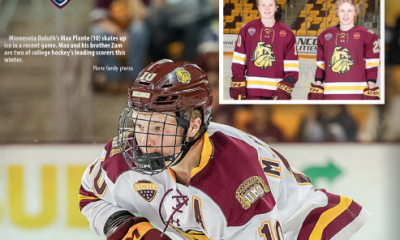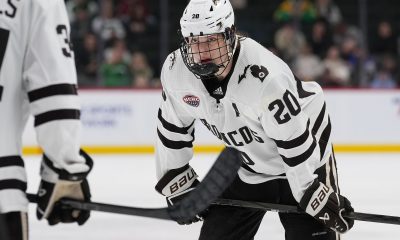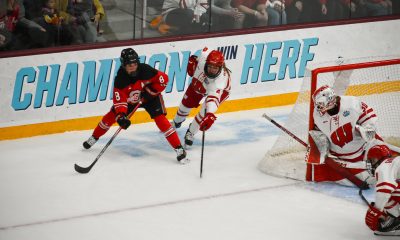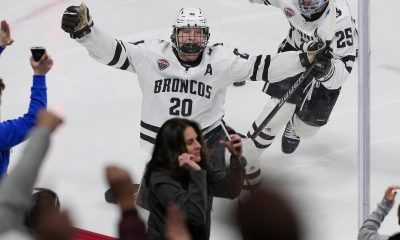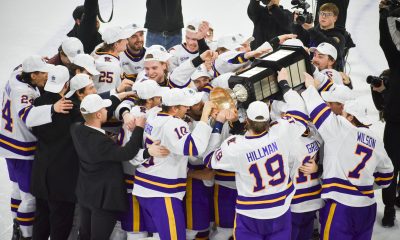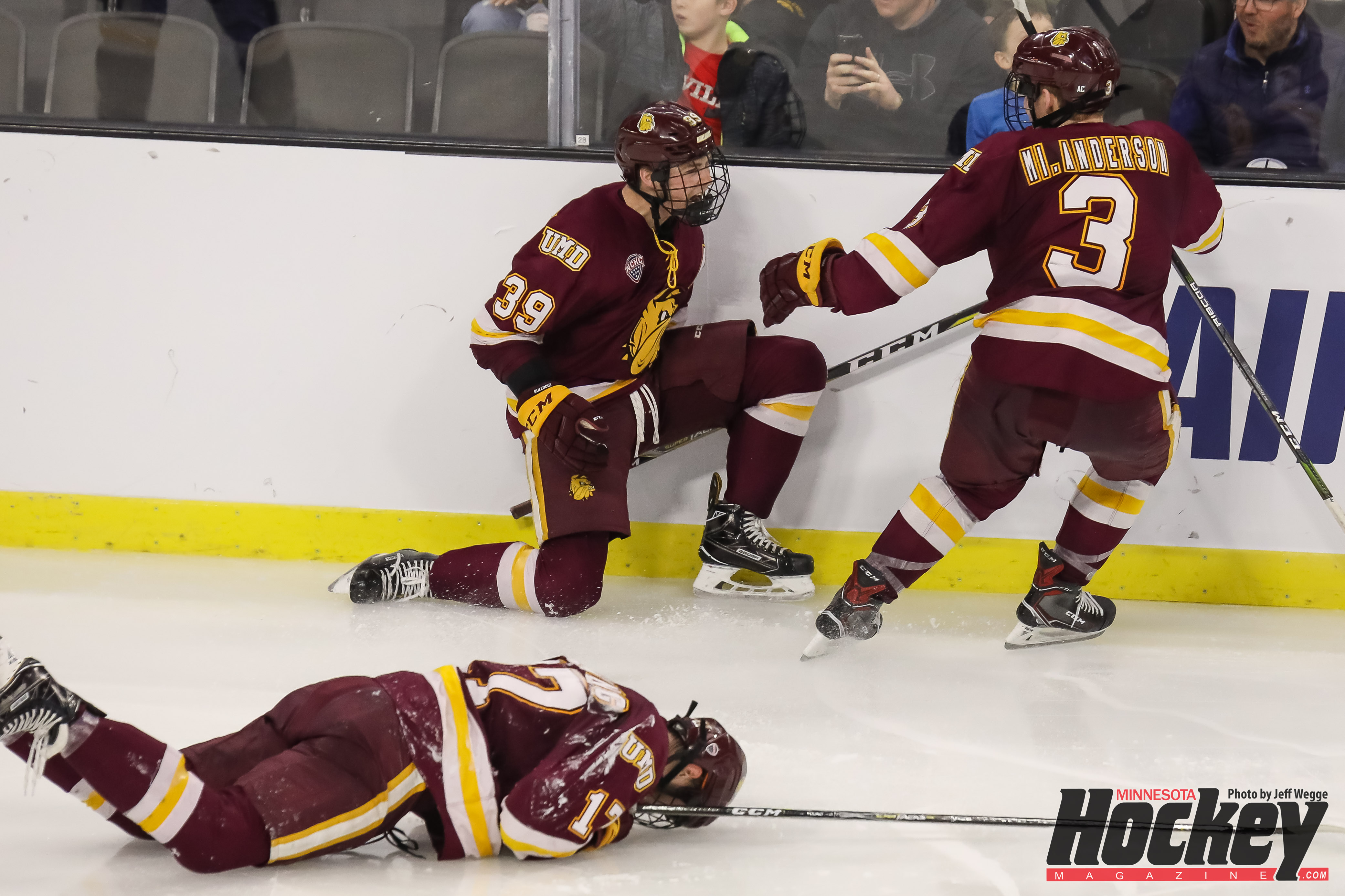
(Featured Photo: UMD’s Parker Mackay (39) celebrates a goal at 2018 Frozen Four, by Jeff Wegge)
From MHM’s Northern Hockey Coverage by John Gilbert
UMD adds depth in attempt to defend NCAA title
The carryover from one college hockey season to the next can distinguish a great hockey program from merely a good one, because consistency is an elusive thing when teams lose six or eight players every year to graduation and pro signings.
For the UMD Bulldogs, the carryover factor has been a consistent asset, despite diametrically opposed circumstances the last two seasons. When they had built a strong, veteran team two years ago, they justifiably reached the NCAA men’s tournament; and last season when they had to fill enormous holes in scoring, on defense, and in goal, and had no projections for success, the Bulldogs not only rose to the playoffs, they won the national championship.
Now what?
The projections are off the scale with the still-young but now-experienced Bulldogs, and it was suggested to Sandelin that if a year’s experience means anything, the only thing left for the 2018-19 UMD team is to go undefeated!
He laughed, but cautioned that every season is a different challenge, even for a team making the impressive transformation from NCAA champion to preseason No. 1 ranked team in the land. “What looks good on paper doesn’t necessarily transform onto the ice,” said Sandelin. “But it will be a tough group to break into.”
In reality, the total number of job openings needing to be broken into is four. Hunter Shepard became a standout last season and is a fixture in goal as a junior, and all six defensemen, five of whom were over-achieving freshmen last season, are back, leaving an impressive incoming group of freshmen with speed and scoring ability to battle for playing time with established returnees for four forward openings.
Shepard is back in goal as a proven junior standout. Nick Wolff is assistant captain as a junior on defense, and those five freshmen defensemen are all back as tournament-hardened sophomores. Scott Perunovich, Dylan Samberg, Mikey Anderson, Louie Roehl and Matt Anderson not only were outstanding on defense, but Wolff, a tough, physical presence who insisted he would never score, backed up the freelancing Perunovich by scoring seven goals, without setting foot on the power play.
It was suggested to Sandelin that there was good news and bad news in Perunovich leading the team in scoring a year ago: The good news was it tells how immensely skilled Perunovich is, and the bad news is …can’t any of the forwards score?
Sandelin got a chuckle out of that, too, and took us back to last season as reason he anticipates goals could come a bit easier this season. New-found depth should ease the replacement of the three departing senior regular forwards, Karson Kuhlman, Jared Thomas and Blake Young — all of whom were assets with their work-ethic and leadership, but are not entirely irreplaceable. When junior Joey Anderson chose to sign a pro contract over the summer, it meant a fourth opening up front.
Of last year’s seniors, Kuhlman, the captain from Cloquet-Esko-Carlton, and Thomas, from Hermantown, were perfect role-models for hard work and perseverance, which may have been more important cogs than scoring 20 goals. They had spent four years mostly hustling and working without scoring in significant numbers. But if effort and leadership made them prominent in the lineup, they were rewarded in storybook fashion by coming through for their biggest career goals at tournament time.
In the championship game against Notre Dame, Kuhlman scored his 13th goal of the season midway through the first period, and 10 minutes later, Thomas scored his 11th goal of his season after Kuhlman had forechecked the puck free to him. That made it 2-0, and the Bulldogs kept hustling, while Shepard took control from there, yielding only a second-period power-play goal to anchor the 2-1 victory.When it ended, Shepard let it all out, racing to the corner of the rink for a high-jump into the boards that would have won Olympic Gold if they had high jumping in goalie pads as an event. The championship was as surprising to Sandelin and his staff as it was to all the opposing teams who took the Bulldogs too lightly until it was too late, then were helpless to stop the momentum.
UMD allowed only 16 goals in its final 12 games last year, evidence of Shepard’s talent and the rapid development of the five freshmen and a sophomore on the kiddie-corps defense. The final twist of statistics was more frosting on the cake: Most of the Frozen Four emphasis going in was on No. 1 ranked Notre Dame and its top-rated goaltender Cale Morris. The 2-1 UMD victory still left Morris with an exceptional 1.94 goals-allowed average, but the unheralded Shepard wound up 1.93.
That .01 difference brought back the .001 edge — one ten-thousandth of a point — in the NCAA’s performance index ratings that let UMD slip past Minnesota for the 16th and final spot in the NCAA tournament field. Notre Dame’s move to the Big Ten and its domination there raised the computer profiles of the whole Big Ten, and despite clear evidence that the NCHC remained the strongest conference in college hockey, three of the Frozen Four teams were from the Big Ten, and Minnesota was close to making it all four.
UMD remained under the radar despite having beaten Minnesota 4-3 in an overtime thriller for the nonconference season opener last season, and head-to-head play figures into the computer. Close as it was, the Bulldogs outshot the Gophers in all four periods that night for a 44-21 total, and won on a goal by Parker Mackay, this year’s captain, and another prospect for scoring more than in his injury limited junior year. Observers say winning that game paid off in the final computer analysis for the .001 edge, but if that victory meant so much, why was Minnesota ever ranked ahead of the Bulldogs? Last year’s opening victory sent them against Minnesota in this year’s opening series having beaten the Gophers an amazing eight straight times.
Most likely, it was a matter of respect, something that Sandelin and the UMD program have worked hard to gain. The Gophers have historic respect as one of the vital programs that hoisted college hockey into the realm of big-time sports. It has taken over a decade for many to realize that the Gophers are no longer the reigning top dog among Minnesota’s five Division 1 programs, as St. Cloud State, Minnesota State and Bemidji State have all risen in competitive strength. UMD may finally have attained that elusive respect, after beating the Gophers for the eighth consecutive time, then ignoring theories about young defense and a lack of scoring, and compensated with hard work and goals-by-committee to keep hanging with the NCHC leaders.
At the end they squeezed into the NCAA tournament’s selected 16 teams by that computerized eyelash, and stayed hot to win the West Regional with come-from-behind one-goal victories over WCHA champ Minnesota State and upstart Air Force to reach the Frozen Four at Xcel Energy Center in Saint Paul.
Once there, sophomore goaltender Shepard continued to be rock solid, and the five freshmen and a sophomore “veteran” on D were even more impressive. The Bulldogs knocked off Ohio State 2-1 in the semifinals, then beat top-seeded Notre Dame by the same 2-1 count to claim their second NCAA title at the same site as their first championship, in 2011. This time, UMD singlehandedly knocked off three Big Ten entries in the Frozen Four, providing the NCHC with its third consecutive national championship in four years of existence.
“I don’t notice any difference in attitude of our guys this year,” Sandelin said. “But we can’t take anything for granted, because getting to the NCAA tournament doesn’t just happen. At the same time, our guys might be even more hungry to prove that we deserve that respect. We’ve got good leadership from our captains, because Parker Mackay, Nick Wolff and Mikey Anderson are all a lot like Karson was.
“We’ll have to make sure we keep working hard, and that we’re not getting too far over our ski tips. We need to have short-term focus, and not the idea we’re going to get there at the end.”
Two years ago, UMD made it to the NCAA Frozen Four with a solid and experienced team, but after that spring of 2017, graduation and early signings sent some Bulldogs into pro hockey and left UMD with some glaring holes. It didn’t seem to matter to Sandelin that he would have one lone defenseman returning, and he was Nick Wolff, only a freshman. Defying dour predictions about the lack of proven goal-scorers, needing to solidify a promising but unproven goaltender, and having to write in the names of five freshmen to join sophomore Wolff on defense every game, Sandelin whistled past the doom and gloom forecasts in the NCHC like a Pied Piper in hockey breezers.
Sandelin gives strong credit to his staff. Brett Larson and Jason Herter were his top assistants, and all three had been defensemen as players. Larson, a primary recruiter of the first UMD championship team, left to become head coach in the USHL, then became top assistant to Steve Rohlik at Ohio State, where he recruited most of the Buckeyes team UMD defeated 2-1 in last spring’s NCAA semifinals. Eventually, Larson returned to UMD and helped recruit most of the current Bulldogs, but now he’s gone to replace Bob Motzko as head coach at St. Cloud State. Larson’s loss will hurt, and while Sandelin is certain Larson will do a great job leading the Huskies, he moved on by making Herter an associate head coach, and hired former two-year UMD captain Adam Krause to leave pro hockey and become his second assistant. His youth, 28, should be an asset in communicating with the team’s young players.
Sandelin may turn up the wick on his laid-back theory of scoring more, knowing how tenuous it was last year, when the Bulldogs always seemed to get just enough contribution from everybody on all four lines, plus that big boost from the rambunctious defensemen.
“We expect more scoring from the forwards,” said Sandelin. “But I don’t mind who scores, as long as somebody scores. We have some returning players who should score more. I expect Riley Tufte to maybe get up to 20 goals, and Nick Swaney, Peter Krieger and Justin Richards could also score more. And we have some freshmen, who, in time, might add to the scoring, because all of them put up good numbers in junior hockey.”
Up front, Krieger and Tufte were together and may remain a tandem, possibly joined by Swaney on their right wing. Richards and captain Parker Mackay — another forward who could add more to the offense — were linemates and may start being centered by freshman Noah Cates. His brother, Jackson Cates, opened at center on another line, and returnees Jade Miller and Billy Exell are now experienced and will be joined by several other incoming freshmen to form units. They can feel secure in knowing that under Sandelin’s new and improved strategy, the lines will be balanced, and the fourth line is allowed to outplay the first line and earn immediate promotion.
“We’ve got some freshmen who are ready to step in and see what they can do, and it’s a nice problem to have, being able to shift guys around with more depth,” said Sandelin. “We’re deeper through the middle, and we’ll move guys around more easily.”
Sandelin also fulfilled his plan of a tough nonconference schedule, which also helps the selection committee’s computer decide who gets the nod in final ratings. “We’ve got a tough first month,” said Sandelin. “We always pride ourselves on a tough nonconference schedule, and this year, after Minnesota, we go to Michigan Tech, then we come home against Maine, and then we go to Notre Dame.”
Ah, Notre Dame. And we promise (wink-wink) to not bring up the fact that UMD beat Notre Dame in the semifinals of the 2011 Frozen Four before knocking off Michigan for the school’s first title, and again beat the Fighting Irish 2-1 in the NCAA final last spring in the same Xcel Center. That’s all history now, of course, and the future is now, couldn’t look brighter.





